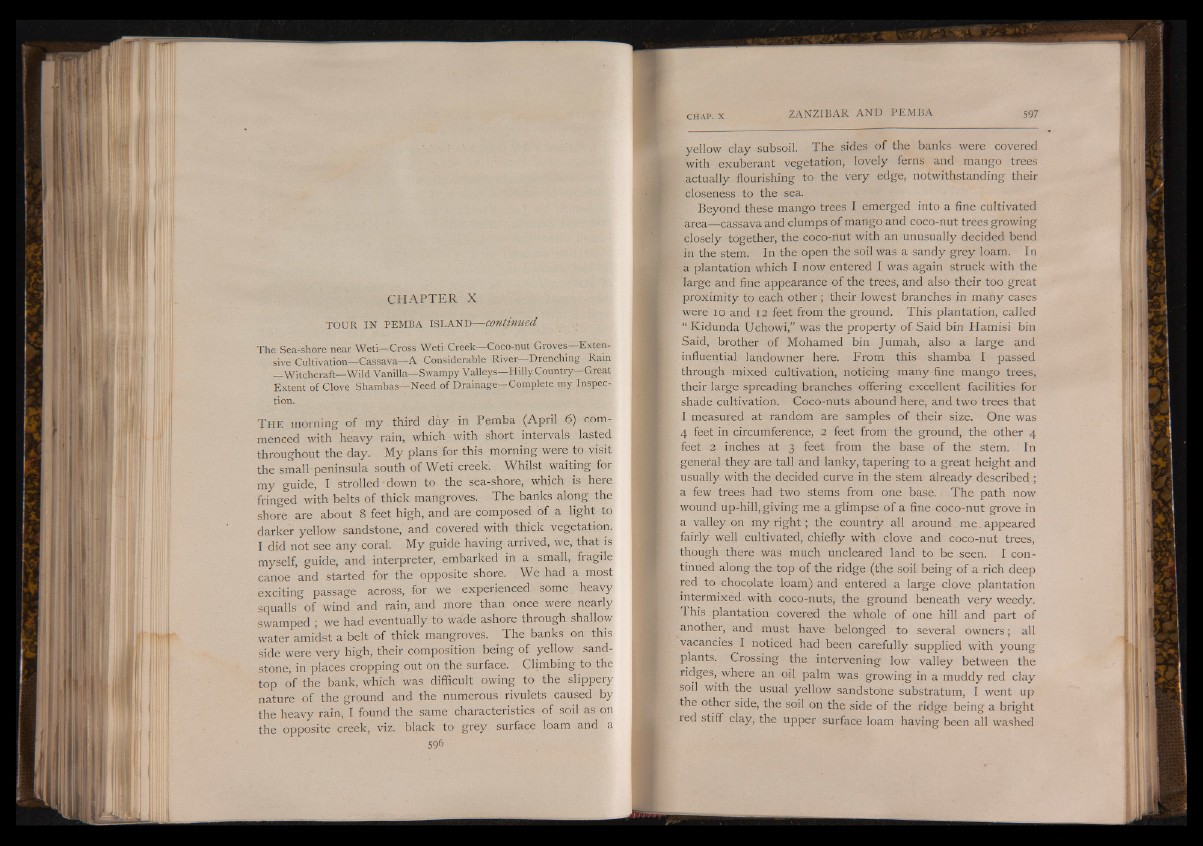
CH APTER X
TOUR IN PEMBA ISLAND:— continued
The Sea-shore near Weti—-Cross Weti Creek#Coco-nut Groves—Extensive
Cultivation— Cassava— A Considerable River— Drenching Rain
Witchcraft— Wild Vanilla— Swampy Valleys— Hilly Country—Great
Extent of Clove Shambas— Need of Drainage— Complete my Inspection.
T h e morning of my third day in Pemba (April 6) commenced
with heavy rain, which with short intervals lasted
throughout the day. My plans for this morning were to visit
the small peninsula south of Weti creek. Whilst waiting for
my guide, I strolled down to the sea-shore, which is here
fringed with belts of thick mangroves. The banks along the
shore, are about 8 feet high, and are composed of a light to
darker yellow sandstone, and covered with thick vegetation.
I did not see any coral, My guide having arrived, we, that is
myself, guide, and interpreter, embarked in a small, fragile
canoe and started for the opposite shore. We had a most
exciting passage across, for we experienced some heavy
squalls of wind and rain, and more than once were nearly
swamped ; we had eventually, to wade ashore through shallow
water amidst a belt of thick mangroves. The banks on this
side were very high, their composition being of yellow sandstone,
in places cropping out on the surface. Climbing to the
top of the bank, which was difficult owing to the slippery
nature of the ground and the numerous rivulets caused by
the heavy rain, I found the same characteristics of soil as on
the opposite creek, viz. black to grey surface loam and a
596
yellow clay subsoil. The sides of the banks were covered
with exuberant vegetation, lovely ferns and mango trees
actually flourishing to the very edge, notwithstanding their
closeness to the sea.
Beyond these mango trees I emerged into a fine cultivated
area— cassava and clumps of mango and coco-nut trees growing
closely together, the coco-nut with an unusually decided bend
in the stem. In the open the soil was a sandy grey loam. In
a plantation which I now entered I was again struck with the
large and fine appearance of the trees, and also their too great
proximity to each other; their lowest branches in many cases
were io and 12 feet from the ground. This plantation, called
“ Kidunda Uchowi,” was the property of Said bin Hamisi bin
Said, brother of Mohamed bin Jumah, also a large and
influential landowner here. From this shamba I passed
through mixed cultivation, noticing many fine mango trees,
their large spreading branches offering excellent facilities for
shade cultivation. Coco-nuts abound here, and two trees that
I measured at random are samples of their size. One was
4 feet in circumference, 2 feet from the ground, the other 4
feet 2 inches at 3 feet from the base of the stem, tn
general they are tall and lanky, tapering to a great height and
usually with the decided curve in the stem Already described ;
a few trees had two stems from one base. The path now
wound up-hill, giving me a glimpse of a fine coco-nut grove in
a valley on my right, the country all around me appeared
fairly well cultivated, chiefly with clove and coco-nut trees,
though there was much uncleared land to be seen. I continued
along the top of the ridge (the soil being of a rich deep
red to chocolate loam) and entered a large clove plantation
intermixed with coco-nuts, the ground beneath very weedy.
This plantation covered the whole of one hill and part of
another, and must have belonged to several owners; all
vacancies I noticed had been carefully supplied with young
plants. Crossing the intervening low valley between the
ridges, where an oil palm was growing in a muddy red clay
soil with the usual yellow sandsto'ne substratum, I went up
the other side, the soil on the side of the ridge being a bright
red stiff clay, the upper surface loam having been all washed